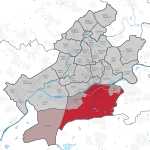Dreikönigskirche, Frankfurt

The Dreikönigskirche (English: Church of the Three Kings) is a Lutheran Protestant church and parish in Frankfurt, the city's largest Protestant parish. It is located on the south bank of the Main in Sachsenhausen, opposite the Frankfurt Cathedral. The present church building, replacing an older church, was erected from 1875 to 1880 on designs by Franz Josef Denzinger in Gothic revival style. It features stained glass windows by Charles Crodel, installed in 1956, and an organ by Karl Schuke from Berlin completed in 1961. After World War II, the church developed into a centre of church music, with Kurt Thomas as the church musician and Helmut Walcha as the organist. It offers cantata services and concerts. The church is a listed monument, basically preserved as originally designed.
Excerpt from the Wikipedia article Dreikönigskirche, Frankfurt (License: CC BY-SA 3.0, Authors, Images).Dreikönigskirche, Frankfurt
Dreikönigsstraße, Frankfurt Sachsenhausen (Süd)
Geographical coordinates (GPS) Address External links Nearby Places Show on map
Geographical coordinates (GPS)
| Latitude | Longitude |
|---|---|
| N 50.107222222222 ° | E 8.6852777777778 ° |
Address
Dreikönigskirche
Dreikönigsstraße
60594 Frankfurt, Sachsenhausen (Süd)
Hesse, Germany
Open on Google Maps










